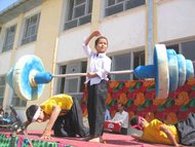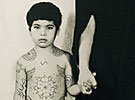Mobile Mini Circus for
Children
Started in the summer of 2002 in the Afghan capital, Kabul, the 'MMCC' aims to support traumatized children. Sponsored mainly from Denmark and the US, the circus pursues therapeutic as well as educational goals. Martin Gerner reports

The circus is currently visiting and performing in Germany and Denmark A map of Germany adorns the wall of the small room in Kabul. Next to it stands a 24-year-old man, Shir Khan. He points to the map: "Most of the people in Germany are Christians; they have a God, too. There are Muslims in Germany as well, but not nearly as many as here."
A group of children sits cross-legged on the ground, attentively following Shir Khan's words. "What is the capital of Germany, Bonn or Berlin?" one of them asks. "What is the most famous place in Germany?" another child wants to know.
Shir Khan, an actor by training, who also teaches these young members of the Children's Circus tricks and theater, unfolds a large information display that some of the coaches have put together.
Improvised lessons about Germany

The children taking part in the circus project come from different ethnic backgrounds Pictures of forests and half-timbered houses, along with castles such as Neuschwanstein, are pasted onto the pages. Also included is Frankfurt with its imposing skyline, and Berlin. Some of the children have heard about the Berlin Wall, but Shir Khan is not able to answer all of their questions as to why the wall was built, how high it was and how long it stood.
During these days, the children sit every morning in this classroom in Kabul for their improvised lessons about Germany. Twelve of them, seven boys and five girls aged between 9 and 16, have hit the jackpot. They belong to the group that will tour Germany and Denmark for two months.
Germany is still a mystery to them, but they have nonetheless been dutifully practicing German folk songs for weeks: "Oh du lieber Augustin, Augustin ...," the young Afghans chime.
"Three days ago, they received a cassette with the German original," explains Berit Mühlhausen, one of the two founding members of the Children's Circus, both foreigners. "We translated the German text into Persian phonetics and, with a little bit of practice, they were able to sing the song."
"Warning: Landmines!"
The circus' trip to Germany is a big adventure. "The children will do acrobatics and juggling on stage, ride unicycles, walk on stilts and perform as clowns," says David Mason, the other founding member.
In addition, the group will present excerpts of programs they perform in Afghanistan. For example, "The Humming Mosquito," in which a boy in a green bodysuit with red paper wings tied to his back plays a malaria-carrying mosquito, from which four additional performers and the curious young audience try to protect themselves.
Most of the performances in Afghanistan deal with the grave dangers young people in the Hindukush face in their daily lives, such as landmines and diarrhea. When the mini-circus plays at schools before peers, a giant white hand made of sponge comes on stage.
The sponge is dirty; underneath it is hidden an actor. In short scenes he acts out how people can protect themselves from dirt: fetching clean water, soaping up their hands and drying them well, doing the same with fruit and other foods.
"Warning: Landmines!" is the name of another piece, excerpts from which the children will be performing in Germany. "We don't re-enact scenes of death and horrible injury here," Berit Mühlhausen explains. "Instead, we put a monkey on stage, who gets hurt badly."
In reality, children die every day in Afghanistan after stepping on landmines. Several million of these treacherous weapons are still slumbering just below the surface of the ground. It is estimated that it would take more than twenty years to clear or destroy them all.
The Children's Circus, whose full name is 'Mobile Minicircus for Children,' has been in existence for two-and-a-half years. Today, it provides artistic training for 80 children, ranging from storytelling and puppet theater to sports and creative radio journalism.
For the other half of the day, the children attend school. "We want to motivate the children to make the most of their own potential; we want to open up new horizons for them and distract them from the poverty in which they live," according to Berit Mühlhausen.
300,000 young viewers so far
Last year, the Children's Circus brought some laughter into the lives of over 25,000 children and youth attending schools in Kabul. Nationwide, the circus performed for an estimated 300,000 young viewers.
These shows help children to deal with the trauma of war and the resulting psychic deformations. "When our oldest performers play in rural areas, there is sometimes a mullah or former Taliban sitting in the audience," David Mason relates. "At first, they sit there unsmiling with crossed arms, but, the longer the program goes on, the more the stern face relaxes, and at the end they even join in the laughter and applause."
The children training for the minicircus have often lost parents or family members in the war. They know what it is to live as a refugee, and frequently have to work to help support their family in addition to attending school and circus training.
The minicircus itself shares in this struggle for survival and is, in a certain sense, a mirror of everyday Afghani reality. Facing a chronic lack of funding, the circus keeps solvent by undertaking short-term projects and offering services such as teacher training, in which the emphasis is on creativity.
Unlike the major aid organizations, the Children's Circus does not possess its own vehicle. The United Nations in Kabul has evidently not yet recognized the value of fostering children, as the circus has been doing with success since November 2003. "They make big plans and talk a lot, but we are more practice-oriented," maintains David Mason.
Martin Gerner
© Qantara.de 2005
Translation from German: Jennifer Taylor-Gaida
Letter to the Editor
Making Mullahs Smile
Started in the summer of 2002 in the Afghan capital, Kabul, the 'MMCC' aims to support traumatized children. Sponsored mainly from Denmark and the US, the circus pursues therapeutic as well as educational goals. Martin Gerner reports

The circus is currently visiting and performing in Germany and Denmark A map of Germany adorns the wall of the small room in Kabul. Next to it stands a 24-year-old man, Shir Khan. He points to the map: "Most of the people in Germany are Christians; they have a God, too. There are Muslims in Germany as well, but not nearly as many as here."
A group of children sits cross-legged on the ground, attentively following Shir Khan's words. "What is the capital of Germany, Bonn or Berlin?" one of them asks. "What is the most famous place in Germany?" another child wants to know.
Shir Khan, an actor by training, who also teaches these young members of the Children's Circus tricks and theater, unfolds a large information display that some of the coaches have put together.
Improvised lessons about Germany

The children taking part in the circus project come from different ethnic backgrounds Pictures of forests and half-timbered houses, along with castles such as Neuschwanstein, are pasted onto the pages. Also included is Frankfurt with its imposing skyline, and Berlin. Some of the children have heard about the Berlin Wall, but Shir Khan is not able to answer all of their questions as to why the wall was built, how high it was and how long it stood.
During these days, the children sit every morning in this classroom in Kabul for their improvised lessons about Germany. Twelve of them, seven boys and five girls aged between 9 and 16, have hit the jackpot. They belong to the group that will tour Germany and Denmark for two months.
Germany is still a mystery to them, but they have nonetheless been dutifully practicing German folk songs for weeks: "Oh du lieber Augustin, Augustin ...," the young Afghans chime.
"Three days ago, they received a cassette with the German original," explains Berit Mühlhausen, one of the two founding members of the Children's Circus, both foreigners. "We translated the German text into Persian phonetics and, with a little bit of practice, they were able to sing the song."
"Warning: Landmines!"
The circus' trip to Germany is a big adventure. "The children will do acrobatics and juggling on stage, ride unicycles, walk on stilts and perform as clowns," says David Mason, the other founding member.
In addition, the group will present excerpts of programs they perform in Afghanistan. For example, "The Humming Mosquito," in which a boy in a green bodysuit with red paper wings tied to his back plays a malaria-carrying mosquito, from which four additional performers and the curious young audience try to protect themselves.
Most of the performances in Afghanistan deal with the grave dangers young people in the Hindukush face in their daily lives, such as landmines and diarrhea. When the mini-circus plays at schools before peers, a giant white hand made of sponge comes on stage.
The sponge is dirty; underneath it is hidden an actor. In short scenes he acts out how people can protect themselves from dirt: fetching clean water, soaping up their hands and drying them well, doing the same with fruit and other foods.
"Warning: Landmines!" is the name of another piece, excerpts from which the children will be performing in Germany. "We don't re-enact scenes of death and horrible injury here," Berit Mühlhausen explains. "Instead, we put a monkey on stage, who gets hurt badly."
In reality, children die every day in Afghanistan after stepping on landmines. Several million of these treacherous weapons are still slumbering just below the surface of the ground. It is estimated that it would take more than twenty years to clear or destroy them all.
The Children's Circus, whose full name is 'Mobile Minicircus for Children,' has been in existence for two-and-a-half years. Today, it provides artistic training for 80 children, ranging from storytelling and puppet theater to sports and creative radio journalism.
For the other half of the day, the children attend school. "We want to motivate the children to make the most of their own potential; we want to open up new horizons for them and distract them from the poverty in which they live," according to Berit Mühlhausen.
300,000 young viewers so far
Last year, the Children's Circus brought some laughter into the lives of over 25,000 children and youth attending schools in Kabul. Nationwide, the circus performed for an estimated 300,000 young viewers.
These shows help children to deal with the trauma of war and the resulting psychic deformations. "When our oldest performers play in rural areas, there is sometimes a mullah or former Taliban sitting in the audience," David Mason relates. "At first, they sit there unsmiling with crossed arms, but, the longer the program goes on, the more the stern face relaxes, and at the end they even join in the laughter and applause."
The children training for the minicircus have often lost parents or family members in the war. They know what it is to live as a refugee, and frequently have to work to help support their family in addition to attending school and circus training.
The minicircus itself shares in this struggle for survival and is, in a certain sense, a mirror of everyday Afghani reality. Facing a chronic lack of funding, the circus keeps solvent by undertaking short-term projects and offering services such as teacher training, in which the emphasis is on creativity.
Unlike the major aid organizations, the Children's Circus does not possess its own vehicle. The United Nations in Kabul has evidently not yet recognized the value of fostering children, as the circus has been doing with success since November 2003. "They make big plans and talk a lot, but we are more practice-oriented," maintains David Mason.
Martin Gerner
© Qantara.de 2005
Translation from German: Jennifer Taylor-Gaida
Qantara.de
Women's Sport in Afghanistan
Training in Secret for Fear of Extremists
Afghanistan's very first fitness and beauty center has recently opened in Kabul. The owner has nonetheless decided to keep its location a secret. Three years after the fall of the Taliban regime, she remains fearful of arousing the fury of those aiming to preserve traditional customs and practices. A report by Ali Matar
Afghan Cinema
"We Were Lacking Just about Everything"
At 25, Roya Sadat is Afghanistan's youngest filmmaker. During the years of the Taliban regime, she sat alone in a small room in Herat and learned about directing by reading American handbooks on filmmaking. Interview by Fahime Farsaie
The Afghan Magazine "Malalai"
The Voice of Afghan Women
Jamila Mujahed is editor of the only women's magazine in Afghanistan. For her work on the magazine "Malalai," which she founded to promote women's rights, she has been awarded the Johann Philipp Palm Prize. Petra Tabeling reports
Interview Siddiq Barmak
An Afghan View of Suffering
Interview "Osama" is the first full-length film to emerge from Afghanistan since the fall of the Taliban regime. It is an attempt to come to terms with the country's history – and it already won a Golden Globe Award. Amin Farzanefar spoke with the film's director Siddiq Barmak
www
Website Mobile Mini Circus for Children
Women's Sport in Afghanistan
Training in Secret for Fear of Extremists
Afghanistan's very first fitness and beauty center has recently opened in Kabul. The owner has nonetheless decided to keep its location a secret. Three years after the fall of the Taliban regime, she remains fearful of arousing the fury of those aiming to preserve traditional customs and practices. A report by Ali Matar
Afghan Cinema
"We Were Lacking Just about Everything"
At 25, Roya Sadat is Afghanistan's youngest filmmaker. During the years of the Taliban regime, she sat alone in a small room in Herat and learned about directing by reading American handbooks on filmmaking. Interview by Fahime Farsaie
The Afghan Magazine "Malalai"
The Voice of Afghan Women
Jamila Mujahed is editor of the only women's magazine in Afghanistan. For her work on the magazine "Malalai," which she founded to promote women's rights, she has been awarded the Johann Philipp Palm Prize. Petra Tabeling reports
Interview Siddiq Barmak
An Afghan View of Suffering
Interview "Osama" is the first full-length film to emerge from Afghanistan since the fall of the Taliban regime. It is an attempt to come to terms with the country's history – and it already won a Golden Globe Award. Amin Farzanefar spoke with the film's director Siddiq Barmak
www
Website Mobile Mini Circus for Children
Letter to the Editor

The current online edition of "Contemporary
Art from the Islamic World" focuses on Iranian-American female artist Shirin
Neshat, on alternative art from Jordan and on Reem Al Faisal's 'El Hajj'
project, among others. Click here for
more...

"Fikrun wa Fann/Art and Thought", the Goethe Institute's
cultural magazine promoting the dialogue with the Islamic world. You can order a
free copy of the magazine's print edition via its website. Click here...
Subscribe to our two-weekly
newsletter and we will keep you informed about news from our site.
Sign off
Sign off












